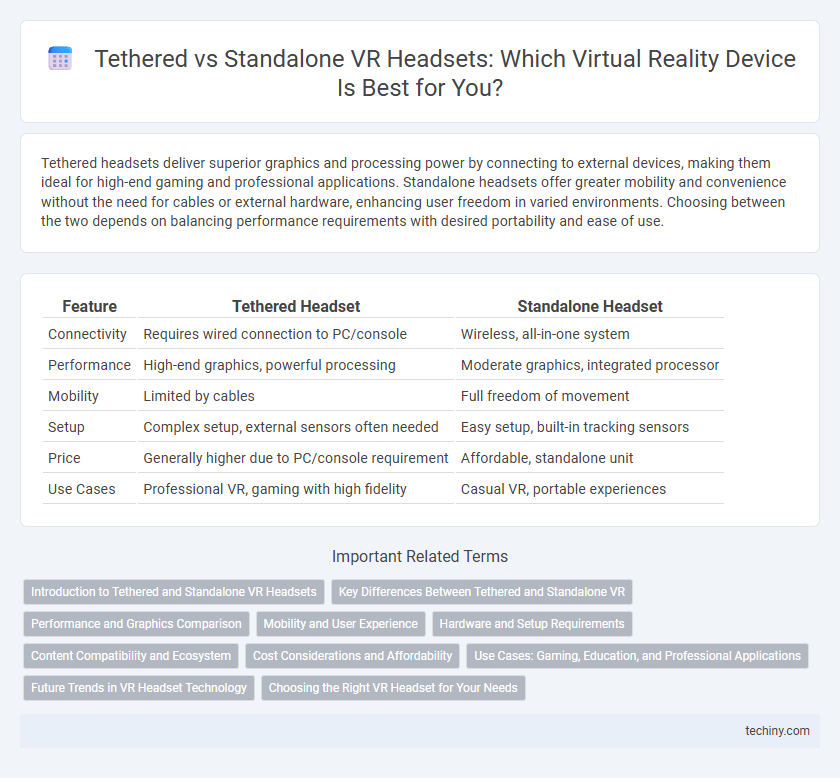Tethered headsets deliver superior graphics and processing power by connecting to external devices, making them ideal for high-end gaming and professional applications. Standalone headsets offer greater mobility and convenience without the need for cables or external hardware, enhancing user freedom in varied environments. Choosing between the two depends on balancing performance requirements with desired portability and ease of use.
Table of Comparison
| Feature | Tethered Headset | Standalone Headset |
|---|---|---|
| Connectivity | Requires wired connection to PC/console | Wireless, all-in-one system |
| Performance | High-end graphics, powerful processing | Moderate graphics, integrated processor |
| Mobility | Limited by cables | Full freedom of movement |
| Setup | Complex setup, external sensors often needed | Easy setup, built-in tracking sensors |
| Price | Generally higher due to PC/console requirement | Affordable, standalone unit |
| Use Cases | Professional VR, gaming with high fidelity | Casual VR, portable experiences |
Introduction to Tethered and Standalone VR Headsets
Tethered VR headsets connect to a PC or gaming console via cables, delivering high-fidelity graphics and low-latency experiences suitable for immersive gaming and professional applications. Standalone VR headsets operate independently with built-in processors, sensors, and storage, offering greater mobility and convenience without the need for external hardware. The choice between tethered and standalone VR depends on the desired experience, performance requirements, and user mobility preferences.
Key Differences Between Tethered and Standalone VR
Tethered VR headsets rely on external hardware such as PCs or gaming consoles, delivering higher graphical fidelity and processing power compared to standalone headsets that operate independently with built-in batteries and onboard processors. Standalone headsets offer greater mobility and ease of use without cables, but generally have limited performance capabilities and shorter battery life. The choice between tethered and standalone VR depends on the desired balance between visual quality, computing power, and user freedom.
Performance and Graphics Comparison
Tethered VR headsets deliver superior performance and graphics quality due to their connection to high-powered PCs, enabling richer textures, higher frame rates, and more complex environments. Standalone headsets rely on built-in processors, which limit graphical fidelity and overall performance but offer greater portability and ease of use. Advanced GPU integration in tethered systems supports intensive VR applications, making them ideal for professional and gaming experiences requiring maximum visual detail.
Mobility and User Experience
Tethered headsets provide higher graphical fidelity and processing power by relying on a connected PC but limit mobility due to cables that restrict movement. Standalone headsets offer greater freedom of movement and convenience with built-in processors and batteries, enhancing user experience in unrestricted environments. However, standalone devices may sacrifice some visual quality and performance compared to tethered options, impacting immersive experiences.
Hardware and Setup Requirements
Tethered VR headsets require high-performance external hardware such as gaming PCs or consoles, along with cables or sensors for precise tracking, resulting in a more complex setup but superior graphics and processing power. Standalone VR headsets integrate all necessary components into a single device, eliminating the need for external hardware and enabling wireless use, which simplifies the setup process but typically offers lower performance compared to tethered systems. Hardware considerations like processing units, tracking technology, and connectivity directly impact the setup time, user mobility, and overall VR experience quality.
Content Compatibility and Ecosystem
Tethered headsets offer extensive content compatibility through direct connection to powerful PCs, enabling access to high-end VR experiences and a broad ecosystem of games and applications. Standalone headsets provide a self-contained ecosystem with increasing support for popular VR content, emphasizing convenience without relying on external hardware. Content availability remains a key factor in choosing between tethered and standalone devices, as tethered systems generally support more complex applications while standalone devices excel in portability and ease of use.
Cost Considerations and Affordability
Tethered VR headsets generally demand a higher initial investment due to the need for a powerful PC or gaming console, often surpassing $1,000 in total setup cost, whereas standalone headsets offer a more budget-friendly all-in-one solution around $300 to $500. The ongoing expenses of tethered systems, including hardware upgrades and maintenance, increase the total cost of ownership, contrasting with the lower, more predictable costs of standalone devices. Affordability for casual users and newcomers leans toward standalone headsets given their plug-and-play nature and absence of ancillary equipment requirements.
Use Cases: Gaming, Education, and Professional Applications
Tethered VR headsets offer superior graphics and processing power, making them ideal for immersive gaming experiences, detailed educational simulations, and complex professional applications like 3D design and medical training. Standalone headsets provide greater portability and ease of use, suitable for casual gaming, mobile educational content, and flexible professional tasks such as remote collaboration and quick prototyping. Both types balance hardware capabilities with user needs across gaming, education, and professional sectors, catering to different levels of immersion and mobility.
Future Trends in VR Headset Technology
Tethered headsets, reliant on external computing power, currently offer superior graphics and performance, but standalone headsets are rapidly advancing with integrated AI processors and improved battery technology, enabling greater mobility and user convenience. Emerging trends highlight hybrid designs that combine the high fidelity of tethered systems with the freedom of standalone devices through wireless streaming and edge computing. Future VR headset technology will emphasize seamless connectivity, enhanced optical displays, and lightweight ergonomics to accommodate increasingly immersive and extended virtual experiences.
Choosing the Right VR Headset for Your Needs
Tethered VR headsets deliver superior graphics and processing power by connecting to external PCs or consoles, ideal for users seeking high-performance experiences and extended playtime. Standalone VR headsets offer greater portability and ease of use with built-in processors and wireless functionality, suited for casual users or those prioritizing convenience. Assessing factors like graphics quality, mobility, budget, and intended use will guide the selection of the most appropriate VR headset.
Tethered headset vs Standalone headset Infographic

 techiny.com
techiny.com